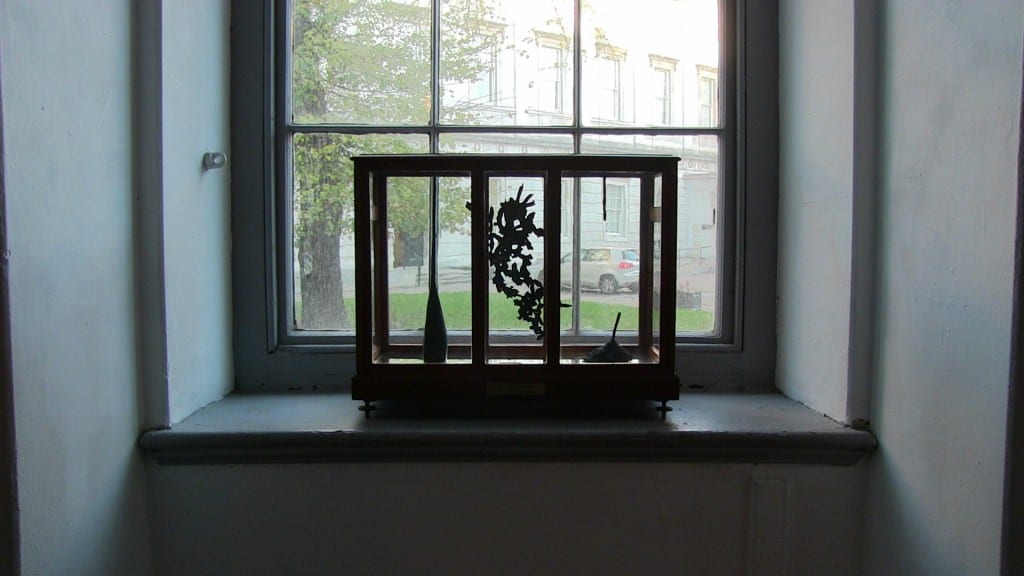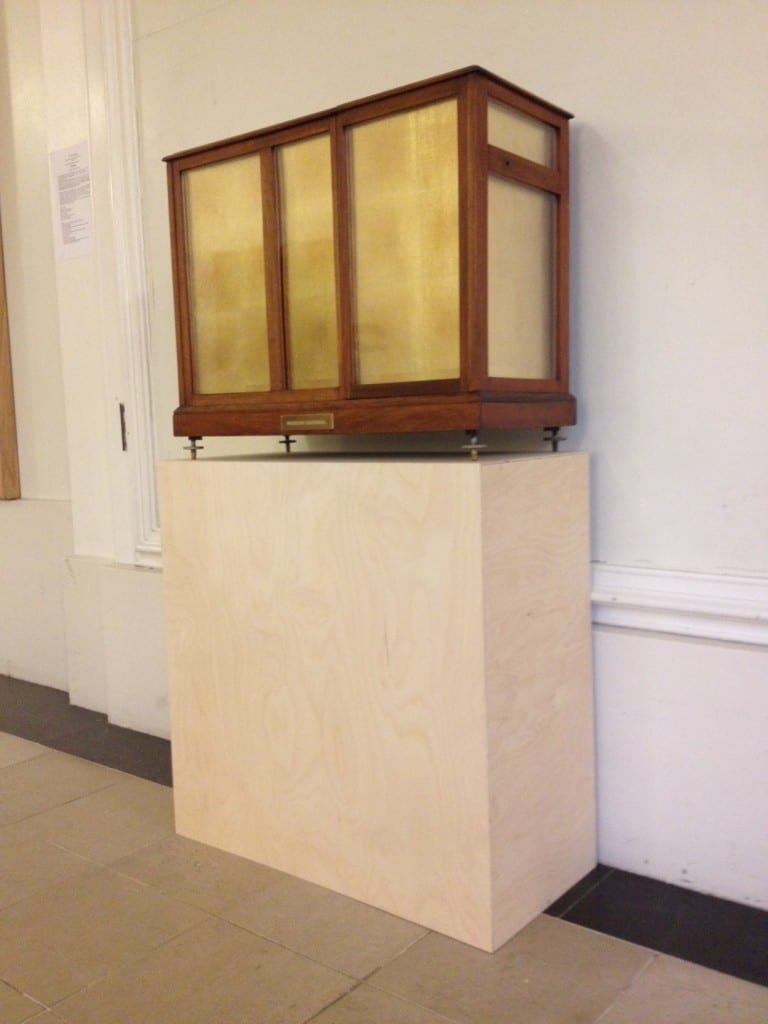Exhibitions
EXHIBITIONS
Contents:
4. ‘copper is restless until it becomes gold……’2014
6. RED (2018)
1. Plasticene, 2012
2. Arbor, 2013
Arbor is a collaborative work between Graduate students Simon Barkworth and Imran Perretta for the Material Museum. The piece on display represents the culmination of joint research into the raw products of the Willow tree and the processes used to harvest materials for art making. Willow is known to yield profoundly dark, dense pigment when processed correctly and both Barkworth and Perretta were interested in the poetic potential of this black pigment in rendering shadow, surface and space.
In the August 2013, the cuttings of a locally sourced, dying tree were collected and dried, ready to be carbonised in a custom built retort in Hampshire. The vines were ‘cooked’ in batches over the course of a week and the raw material that was left behind was shared between the artists to be used in two discreet works, ‘Hold’ by Perretta and ‘Not now, I’m in a good mood’ by Barkworth. The resultant charcoal was used by Perretta as a drawing material to create a blackened space, cloaking the room in darkness as part of a video installation, and by Barkworth as a rich, powdery black pigment to render the image of a malevolent Crow, poised atop a column in the exhibition space. Although displayed apart, the works remained inexorably tethered by their material origin, twinned by the process of carbonisation and mutual in their exploration of darkness.
Arbor is a sculptural assemblage that uses the spent material from both ‘Hold’ and ‘Not now, I’m in a good mood’ to create a series of unified objects that share the same dying Willow tree as their source. The charcoal is set using Gum Arabic, a substrate that is sourced from the sap of an Acacia tree and becomes the binding agent of the artist’s parallel works. The piece looks at the layering of process and material in the act of art making. From procuring and processing the raw material to the creation of an artwork to the harvest of its eventual waste, the work on show uses the physical product of this alchemical layering and reflects on its poetic materiality. This transubstantiation of process and matter yields a new meta-material that is simultaneously raw and processed, both pure and contaminated and at once imbued with the experience and labour of its makers.
Simon Barkworth and Imran Perretta
****************************************************************************
Materials:
Charcoal
Charcoal is a light black residue consisting of carbon, and any remaining ash, obtained by removing water and other volatile constituents from animal and vegetation substances. Charcoal is usually produced by heating of wood or other substances in the absence of oxygen. It is usually an impure form of carbon as it contains ash; however, sugar charcoal is among the purest forms of carbon readily available, particularly if it is not made by heating but by a dehydration reaction with sulfuric acid to minimise introducing new impurities, as impurities can be removed from the sugar in advance. The resulting soft, brittle, lightweight, black, porous material resembles coal.
Charcoal has been used since the earliest times for a range of purposes including art and medicine, but by far its most important use has been as a metallurgical fuel. Charcoal is the traditional fuel of a blacksmith’s forge and other applications where an intense heat is wanted. Charcoal was also used historically as a source of carbon black by grinding it up. In this form charcoal was important to early chemists and was a constituent of formulas for mixtures such as gunpowder. Due to its high surface area charcoal can be used as a filter, as a catalyst or as an adsorbent.
Charcoal is used in art for drawing, making sketches in painting and is one of the possible media for making a parsemage. It must usually be preserved by the application of a fixative. Artists generally utilize charcoal in three forms: Vine charcoal is created by burning sticks of wood (usually willow or linden/Tilia) into soft, medium, and hard consistencies. Powdered charcoal is often used to “tone” or cover large sections of a drawing surface. Drawing over the toned areas darkens it further, but the artist can also lighten (or completely erase) within the toned area to create lighter tones. Compressed charcoal is charcoal powder mixed with gum binder compressed into round or square sticks. The amount of binder determines the hardness of the stick. Compressed charcoal is used in charcoal pencils. Charcoal is also used metallurgical and industrial fuel, cooking, Syngas production and automotive fuel, gunpowder Carbon source Purification and filtration.
Ash
‘Indeed, if one goes into this apparently uninteresting subject in any depth there is a quite a lot about it which is not at all uninteresting; if, for example, one blows on ash it displays not the least reluctance to fly off in all directions. Ash is submissiveness, worthlessness, irrelevance itself, and best of all, it is itself pervaded by the belief that it is fit for nothing. Is it possible to be more helpless, more impotent, and more wretched that ash? Not very easily. Could anything be more compliant and more tolerant? Hardly. Ash has no notion of character and is further from any kind of wood than dejection is from exhilaration. Where there is ash there is actually nothing at all. Tread on ash, and you will barely notice you have stopped on anything.’ Robert Walser
Gum arabic
Gum Arabic also known as acacia gum, chaar gund, char goond, or meska, is a natural gum made of hardened sap taken from two species of the acacia tree; Senegalia senegal and Vachellia seyal. The gum is harvested commercially from wild trees throughout the Sahel from Senegal to Somalia, although it has been historically cultivated in Arabia and West Asia. Gum arabic is a complex mixture of glycoproteins and polysaccharides. It was historically the source of the sugars arabinose and ribose, both of which were first discovered and isolated from it, and are named after it. Gum arabic is used primarily in the food industry as a stabilizer. It is edible and has E number E414. Gum arabic is a key ingredient in traditional lithography and is used in printing, paint production, glue, cosmetics and various industrial applications, including viscosity control in inks and in textile industries, although less expensive materials compete with it for many of these roles. While gum arabic is now produced mostly throughout the African Sahel, it is still harvested and used in the Middle East. For example, Arab populations use the natural gum to make a chilled, sweetened, and flavored gelato-like dessert.
3. White Bone Black, 2013
4. ‘copper is restless until it becomes gold……’ 2014
MATERIAL MUSEUM in conjunction with UCL Festival of the Arts, Tuesday 27 – Friday 30 May 2014. ‘copper is restless until it becomes gold…’ is a collaborative work by Simson&Volley.
Simson&Volley’s new work for the Material Museum ‘copper is restless until it becomes gold…..’ holds in mind Meister Eckhart’s (c.1260-1328, German theologian, philosopher and mystic), words and attempts to transform base metal into gold. The works is about reflection, the physical qualities of material and their imagined metamorphosis.
Simson&Volley is a partnership between the artists Henrietta Simson and Jo Volley. Although practicing artist in their own right the collaborative process allows the subsuming and exploration of shared interests. Mel Gooding, the eminent British art writer and critic, described Simson&Volley’s collaboration as ‘a lovely dual-imagination at work between media, scales and dimensions, intellectually clear and uncluttered. A meeting of good and vibrant minds, not afraid of beauty as fact or idea’.
5. Blue from Iron
David Dobson
Slade Scientist in Residence
The colour of most minerals arises from electronic charge transfer between transition metals – most commonly between iron in its tow valence states of 2+ (ferrous iron) and 3+ (ferric iron). In most minerals the iron is surrounded by 6 oxygens in octahedral coordination; this results in reds and yellows in ferric-dominated minerals and greens in ferrous-dominated minerals. If the iron ion ends up in tetrahedral coordination (only 4 oxygens surrounding it) then a blue colour is produced – this is the colour centre in Prussian blue – but this is very rare in natural silicate minerals because the normal tetrahedral sites are too small to take the ferric ion. Iron can be forced into tetrahedral coordination in silicates by pressure which compresses the ferric ion faster than the silicate ion.
High-pressure experiments have shown that several bright blue silicate minerals exist with ferric iron in tetrahedral coordination. At low pressures serpentine dehydrates into olivine, pyroxene and haematite, giving the mixture a rust-red colouration. Above 80,000 atmospheres pressure serpentine forms pyroxene plus ‘phase A’ which contains tetrahedral Fe3+ and is a rich royal blue colour. Olivine transforms into ringwoodite at pressures above 200,000 atmospheres with ferric iron sitting on the silicon site, charge balanced by a proton – again very rich blue. These minerals are no good as pigments as we can only synthesise them in milligram quantities and they are not stable under normal conditions.
It is possible to force iron into tetrahedral coordination at low pressures by replacing the silicon ion with a larger species; phosphorous and germanium are good candidates. Vivianite is a hydrated iron (2+) phosphate which is white when pure, but on exposure to air some of the ferrous iron oxidises to ferric iron, producing the blue colour found in blue earths. Synthetic vivianite starts off a very pale blue and takes several weeks to darken to its final colour. The zinc silicates and germanates are interesting candidate materials as all of the structural sites are in tetrahedral coordination so should produce blue-iron bearing compounds. Work is ongoing to see how much iron can be dissolved into these materials and hence how blue they can be made.
6. RED
This exhibition is one of the research outcomes of a project completed during the Summer 2018 by UCL students Alexa Marroquin and Jessica Manuel, supervised by Ruth Siddall. Jessica and Alexa are both successful recipients of UCL Laidlaw Scholarships, which gives them the opportunity to undertake academic research in their first year of undergraduate study. Their project, ‘Red in Roman Britain’ has looked at the range of red pigments available to Romano-British artists and together they have made a comparative study of the ancient pigments available and their modern analogues; rose madder, red lead, cinnabar/vermillion and red ochre. Alexa is studying for an MSci Chemistry and Jessica is studying for a BA History of Art with Material Studies at UCL. Together they have performed scientific analyses of the pigments and also prepared pigments as paints to test their workability and colour.
Find out more about the Laidlaw Scholarships Programme at www.ucl.ac.uk/laidlaw-scholarships/
 Close
Close







